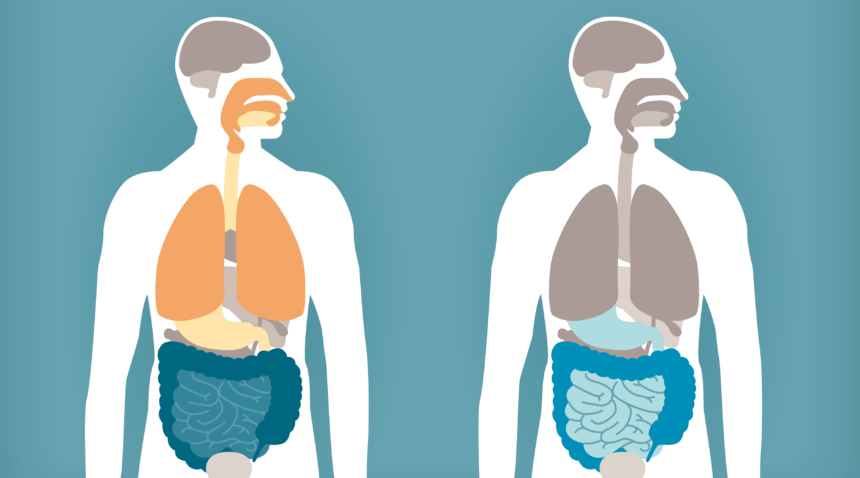For many people, certain foods and drinks should come with a giant yellow hazard label: WARNING—RUN AWAY! Depending on the individual, seemingly harmless ingredients, such as milk, egg, soy and wheat, can wreak havoc.
So if this misery happens when you eat a certain food, are you allergic to it or just intolerant?
Important Differences Between Allergies and Intolerances
First, some definitions: A food allergy is an immediate, hypersensitive response to a food triggered by the body’s immune system.
“In patients with food allergy, even ingesting a tiny amount of the culprit food can cause an allergic reaction. This exposure causes the immune system to produce histamine and other factors that can cause symptoms ranging from itching and hives to a severe, life-threatening reaction known as anaphylaxis,” says Saira Sheikh, MD, an allergist/immunologist and rheumatologist with the UNC Allergy and Immunology Clinic and UNC Hospitals Rheumatology Specialty Clinic.
The symptoms of a food allergy can include but are not limited to:
- Itchy, watery eyes
- Runny nose
- Hives
- Swelling of the lips and throat
- Abdominal pain, nausea and vomiting
- Difficulty breathing and wheezing
- Drop in blood pressure and heart rate
Food intolerance, on the other hand, occurs when you have difficulty tolerating particular foods. This results in gastrointestinal symptoms such as gas, abdominal pain or diarrhea. It’s not life-threatening, but it can be very uncomfortable.
“In the majority of people with these symptoms, it ends up being a sensitive GI tract. Either on the upper side, which causes nausea, feeling full or heartburn-type symptoms, or lower, causing diarrhea or cramping,” says Evan Dellon, MD, MPH, a gastroenterologist with UNC Gastrointestinal Medicine.
The takeaway? “Food allergy is mediated by the immune system and can involve various organ systems in the body, whereas food intolerance primarily involves the digestive system,” Dr. Sheikh says.
Other important differences between food allergies and food intolerances include:
- Time: Symptoms of a true allergic reaction often occur immediately after exposure to even a miniscule amount of the food. A food intolerance generally takes longer to emerge and can last for hours or days after you’ve eaten the food. (One exception is the alpha-gal allergy to red meat, which can take hours to manifest.)
- Severity: Food allergies can kill you, whereas food intolerances just make you feel bad. People with food allergies should avoid their trigger foods no matter what. Some people with intolerance can have smaller amounts of that food.
Take milk, for example. People with a milk allergy can have a severe allergic reaction to even a small amount of milk. This could include gastrointestinal problems as well as skin and respiratory symptoms. On the other hand, those who are lactose intolerant primarily experience gastrointestinal symptoms and often can tolerate small amounts of dairy. The allergy is the immune system responding to protein in milk; the intolerance is because the person’s gut is missing an enzyme that is meant to help digest lactose, which is a sugar found in milk.
Diagnosing Food Allergies and Food Intolerances
Knowing whether you have an allergy or intolerance is important because food allergies are potentially life-threatening. People with food allergies should carry emergency lifesaving medications, such as epinephrine in an injectable form.
The diagnosis of a food allergy is made based on a history of a reaction to a food and a positive skin or blood test that confirms the allergy.
For example, “if you eat shrimp and you develop hives on your skin and swelling of your lips immediately afterwards, there is a strong clinical suspicion for shrimp allergy, so we would confirm this diagnosis with allergy testing by skin prick method or by blood test,” Dr. Sheikh says.
A positive skin or blood test alone, without symptoms suggestive of an allergic reaction, means your body may be sensitized but not necessarily that you’re allergic.
Food intolerance is sometimes difficult to diagnose because there’s no accurate, validated test to identify food intolerance.
“A good way to identify if a food is causing intolerance is to keep a food diary to track and recognize what regularly eaten food may be causing an adverse reaction,” Dr. Sheikh says.
“Symptoms associated with a food intolerance that we worry about and say see a doctor as soon as possible would be sudden weight loss, blood in the stool, throwing up blood and having food stick when you swallow,” Dr. Dellon says. Those could indicate a more serious condition.
Treating Food Allergies and Food Intolerances
Whether you’re allergic to a food or intolerant of it, you’ll want to avoid it. If that fails, your treatment options are:
- Food allergy: The drug of choice is epinephrine, which comes in an injectable pen. “Basically, it jump-starts your heart,” Dr. Sheikh says. During a severe allergic reaction, your blood pressure can drop. “Epinephrine causes tightening or constriction of blood vessels, which increases blood pressure and helps to reverse or prevent cardiovascular collapse. It also relaxes the muscles in the airways and lungs, which helps the airways to open up.” If symptoms are mild, it is reasonable to take an antihistamine. For severe symptoms, if in doubt about whether to use epinephrine or an antihistamine, always go with epinephrine, Dr. Sheikh says. “It is the main therapy that should be used in the management of anaphylaxis.”
- Food intolerance: Unfortunately, you’ll probably have to wait out the discomfort with the help of over-the-counter gut soothers. Food intolerance is often tied to irritable bowel syndrome (IBS), which can be treated with dietary changes such as the low-FODMAP diet; FODMAPs are compounds that aggravate IBS.
Whatever you think the problem is, you don’t have to figure it out on your own, Dr. Dellon says. “Talk to your doctor about what’s going on, and then together you can decide if you need to see a gastroenterologist or an allergist for further diagnosis and treatment.”

Having trouble with certain food? Find an allergist or gastroenterologist near you.

